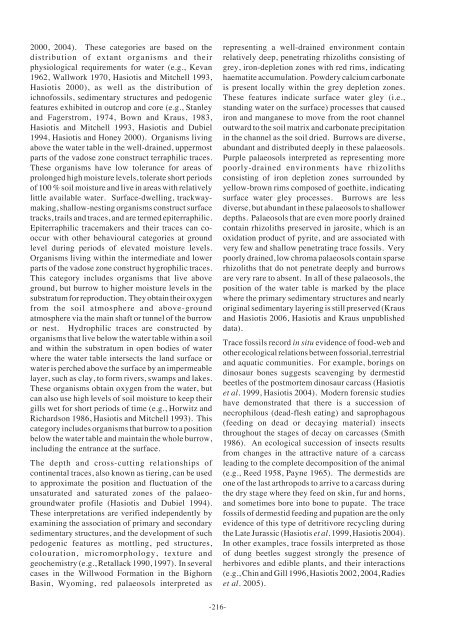Continental trace fossils and museum exhibits - Geological Curators ...
Continental trace fossils and museum exhibits - Geological Curators ...
Continental trace fossils and museum exhibits - Geological Curators ...
Create successful ePaper yourself
Turn your PDF publications into a flip-book with our unique Google optimized e-Paper software.
2000, 2004). These categories are based on thedistribution of extant organisms <strong>and</strong> theirphysiological requirements for water (e.g., Kevan1962, Wallwork 1970, Hasiotis <strong>and</strong> Mitchell 1993,Hasiotis 2000), as well as the distribution ofichno<strong>fossils</strong>, sedimentary structures <strong>and</strong> pedogenicfeatures exhibited in outcrop <strong>and</strong> core (e.g., Stanley<strong>and</strong> Fagerstrom, 1974, Bown <strong>and</strong> Kraus, 1983,Hasiotis <strong>and</strong> Mitchell 1993, Hasiotis <strong>and</strong> Dubiel1994, Hasiotis <strong>and</strong> Honey 2000). Organisms livingabove the water table in the well-drained, uppermostparts of the vadose zone construct terraphilic <strong>trace</strong>s.These organisms have low tolerance for areas ofprolonged high moisture levels, tolerate short periodsof 100 % soil moisture <strong>and</strong> live in areas with relativelylittle available water. Surface-dwelling, trackwaymaking,shallow-nesting organisms construct surfacetracks, trails <strong>and</strong> <strong>trace</strong>s, <strong>and</strong> are termed epiterraphilic.Epiterraphilic <strong>trace</strong>makers <strong>and</strong> their <strong>trace</strong>s can cooccurwith other behavioural categories at groundlevel during periods of elevated moisture levels.Organisms living within the intermediate <strong>and</strong> lowerparts of the vadose zone construct hygrophilic <strong>trace</strong>s.This category includes organisms that live aboveground, but burrow to higher moisture levels in thesubstratum for reproduction. They obtain their oxygenfrom the soil atmosphere <strong>and</strong> above-groundatmosphere via the main shaft or tunnel of the burrowor nest. Hydrophilic <strong>trace</strong>s are constructed byorganisms that live below the water table within a soil<strong>and</strong> within the substratum in open bodies of waterwhere the water table intersects the l<strong>and</strong> surface orwater is perched above the surface by an impermeablelayer, such as clay, to form rivers, swamps <strong>and</strong> lakes.These organisms obtain oxygen from the water, butcan also use high levels of soil moisture to keep theirgills wet for short periods of time (e.g., Horwitz <strong>and</strong>Richardson 1986, Hasiotis <strong>and</strong> Mitchell 1993). Thiscategory includes organisms that burrow to a positionbelow the water table <strong>and</strong> maintain the whole burrow,including the entrance at the surface.The depth <strong>and</strong> cross-cutting relationships ofcontinental <strong>trace</strong>s, also known as tiering, can be usedto approximate the position <strong>and</strong> fluctuation of theunsaturated <strong>and</strong> saturated zones of the palaeogroundwaterprofile (Hasiotis <strong>and</strong> Dubiel 1994).These interpretations are verified independently byexamining the association of primary <strong>and</strong> secondarysedimentary structures, <strong>and</strong> the development of suchpedogenic features as mottling, ped structures,colouration, micromorphology, texture <strong>and</strong>geochemistry (e.g., Retallack 1990, 1997). In severalcases in the Willwood Formation in the BighornBasin, Wyoming, red palaeosols interpreted asrepresenting a well-drained environment containrelatively deep, penetrating rhizoliths consisting ofgrey, iron-depletion zones with red rims, indicatinghaematite accumulation. Powdery calcium carbonateis present locally within the grey depletion zones.These features indicate surface water gley (i.e.,st<strong>and</strong>ing water on the surface) processes that causediron <strong>and</strong> manganese to move from the root channeloutward to the soil matrix <strong>and</strong> carbonate precipitationin the channel as the soil dried. Burrows are diverse,abundant <strong>and</strong> distributed deeply in these palaeosols.Purple palaeosols interpreted as representing morepoorly-drained environments have rhizolithsconsisting of iron depletion zones surrounded byyellow-brown rims composed of goethite, indicatingsurface water gley processes. Burrows are lessdiverse, but abundant in these palaeosols to shallowerdepths. Palaeosols that are even more poorly drainedcontain rhizoliths preserved in jarosite, which is anoxidation product of pyrite, <strong>and</strong> are associated withvery few <strong>and</strong> shallow penetrating <strong>trace</strong> <strong>fossils</strong>. Verypoorly drained, low chroma palaeosols contain sparserhizoliths that do not penetrate deeply <strong>and</strong> burrowsare very rare to absent. In all of these palaeosols, theposition of the water table is marked by the placewhere the primary sedimentary structures <strong>and</strong> nearlyoriginal sedimentary layering is still preserved (Kraus<strong>and</strong> Hasiotis 2006, Hasiotis <strong>and</strong> Kraus unpublisheddata).Trace <strong>fossils</strong> record in situ evidence of food-web <strong>and</strong>other ecological relations between fossorial, terrestrial<strong>and</strong> aquatic communities. For example, borings ondinosaur bones suggests scavenging by dermestidbeetles of the postmortem dinosaur carcass (Hasiotiset al. 1999, Hasiotis 2004). Modern forensic studieshave demonstrated that there is a succession ofnecrophilous (dead-flesh eating) <strong>and</strong> saprophagous(feeding on dead or decaying material) insectsthroughout the stages of decay on carcasses (Smith1986). An ecological succession of insects resultsfrom changes in the attractive nature of a carcassleading to the complete decomposition of the animal(e.g., Reed 1958, Payne 1965). The dermestids areone of the last arthropods to arrive to a carcass duringthe dry stage where they feed on skin, fur <strong>and</strong> horns,<strong>and</strong> sometimes bore into bone to pupate. The <strong>trace</strong><strong>fossils</strong> of dermestid feeding <strong>and</strong> pupation are the onlyevidence of this type of detritivore recycling duringthe Late Jurassic (Hasiotis et al. 1999, Hasiotis 2004).In other examples, <strong>trace</strong> <strong>fossils</strong> interpreted as thoseof dung beetles suggest strongly the presence ofherbivores <strong>and</strong> edible plants, <strong>and</strong> their interactions(e.g., Chin <strong>and</strong> Gill 1996, Hasiotis 2002, 2004, Radieset al. 2005).-216-
















